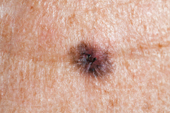Melanocytes are cells that produce dark skin pigment known as melanin. Melanin is what gives your skin color. At times, melanocytes may clump into a group forming a nevus (plural nevi) or mole. Nevi can be classified as either common or abnormal (atypical) moles.
Moles (Nevi) versus Melanoma
A nevus is a non-cancerous (benign) mole. Moles are generally not congenital (present at birth). Rather, they are acquired in childhood or later in the teenage years. The majority of common moles never become problematic. However, if a person has in excess of fifty normal moles or greater than five of the atypical variety, also known as “dysplastic” moles, he or she has an increased chance of getting melanoma. The most aggressive type of skin cancer is melanoma.
Differentiating between common moles and melanoma tumors can be difficult even for a dermatologist with many years of training and practice. Therefore, it is extremely important to be as educated as possible in order to protect yourself from developing serious forms of skin cancer like melanoma. If you inform yourself and learn the differences between a melanoma tumor and a normal mole, you could save your own life or the lives of others you love.
How do I Tell the Difference?
While melanoma is much less common than other types of skin cancers, it is the most deadly. It is responsible for approximately 80% of all deaths attributed to skin cancer. The following sections will show the differences between common moles, atypical nevi and melanoma tumors.
Common Moles
A normal “common” mole has an almost perfectly round shape rather than being lopsided (asymmetrical). It is less than five millimeters in diameter, as well as uniform in color. Common moles can be many different colors including brown, black, tan, pink, red, blue, skin colored or even have no color at all. With common moles, the shape, size and color do not change from one month to the next.
Dysplastic or Atypical Moles
While the majority of moles are non-cancerous, some types do carry a higher risk of eventually developing into melanoma. Approximately 2 to 8% of the American Caucasian population has dysplastic (atypical) moles. Compared to normal moles, they are bigger in diameter (five millimeters wide or more). Abnormal moles have irregular borders and are various shades or colors. People with dysplastic nevi and a family history of melanoma are at a much greater risk of getting melanoma before forty years of age.
Malignant Melanoma
Recognizing changes in the overall appearance of your skin as well as any changes in the way your existing moles look both are effective ways to discover melanoma tumors early in the disease process. Melanoma can develop anywhere on the body, but the most common areas include the upper part of the back, torso, lower legs, neck and head. Use the simple but extremely effective ABCDE guide for detecting the early signs of a melanoma tumor:
- Asymmetry: Mole appears lopsided, where one half does not look like the other half.
- Border: Edges of the mole are ragged, blurred or notched.
- Color: Coloration lacks uniformity. Different shades of brown, black or tan will often be present. Red, white or blue dashes may contribute to the overall mottled appearance.
- Diameter: Generally, melanomas are more than six millimeters in diameter when diagnosed as malignant. However, they can be smaller.
- Evolving: The mole or sore seems different from others, or there is a noticeable change in color, size, shape or consistency of a mole.
Skin Care and Melanoma Prevention Tips
If you or your dermatologists detects melanoma early and treats it promptly, you have close to a 100% cure rate. To increase the probability that any melanoma tumor will be detected sooner rather than later and to avoid melanoma, follow this guideline.
- Use ABCDE – The American Academy of Dermatology strongly recommends using the ABCDE list to examine your entire body on a regular basis for any changes in the appearance of your skin.
- Go to the doctor – Consult a dermatologist as soon as possible if you find an unusual skin lesion. Things to watch for include a mole that seems to be growing in size, bleeding or does not look like the rest of your moles.
- Go and get a free cancer screening – The American Academy of Dermatology offers free screenings at locations throughout the country.
- Avoid harmful rays – Stop the risky practices of sun tanning or using a commercial tanning bed or other equipment.
- Use protective coverings – Wear SPF 30 or greater UVA/UVB sunscreen, wear a hat, sunglasses and long, and choose loose fitting clothing whenever you go outside to enjoy the sunshine.
- Try to avoid peak sun times – The worst times to be outside are between 10AM and 2PM, when harmful ultraviolet rays from the sun are the most intense.

